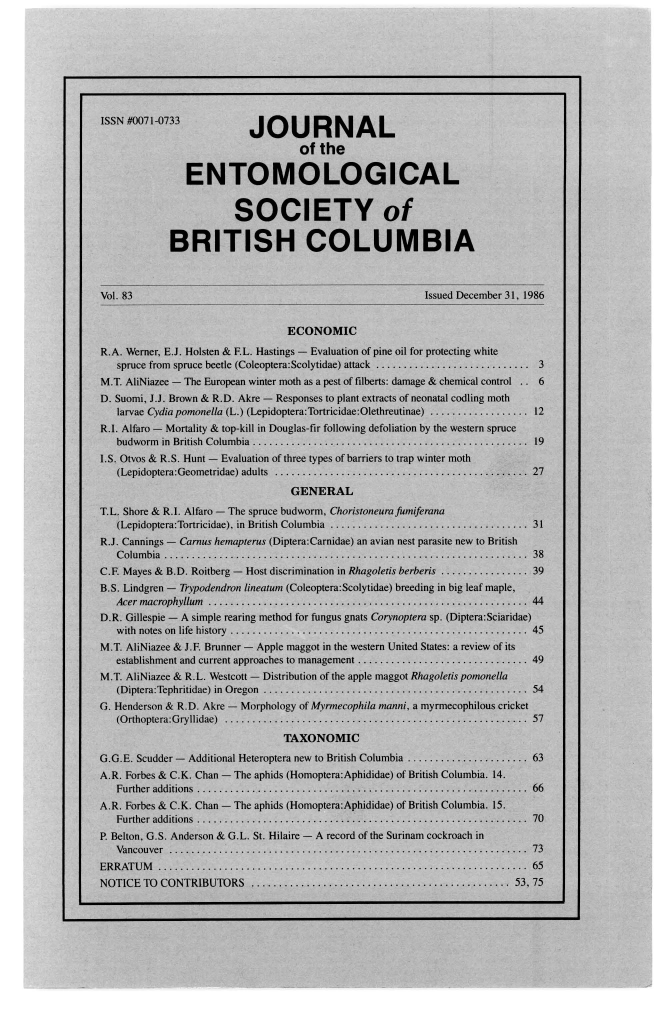Host discrimination in <i>Rhagoletis berberis</i> (Diptera: Tephritidae)
Keywords:
<i>Rhagoletis berberis</i>, Diptera, TephritidaeAbstract
Following oviposition, females of <i>Rhagoletis berberis</i> Curran (Tephritidae), appear to deposit host marking pheromones on the surface of their host fruit, <i>Mahonia</i> (Berberacidae), and discriminate against such marked hosts when choosing oviposition sites. Marking is accomplished by dragging the ovipositor on the fruit surface, resulting in the deposition of a fluid trail. In addition to these findings, females were observed feeding on the juice of host fruit through punctures made with their ovipositors. Therefore, the incidence of fly feeding was compared with successful and unsuccessful oviposition.References
Bush, G.L. 1961. Rhagoletis in North America. Bulletin of the Museum of Comparative Zoology. 134(11):508-511.
Price, P.W. 1970. Trail odours: Recognition by insects parasitic on cocoons. Science 170:546-547.
Prokopy, R.J. and E.F. Boller. 1971. Artificial egging system for the European cherry fruit fly. Journal of Economic Entomology. 63:1413-1417.
Prokopy, R.J. 1981. Oviposition deterring pheromone system of apply maggot flies. Pp. 477-494. In: E.R. Mitchell (ed.). Management of Insect Pests with Semiochemicals. Plenum Publishing Corporation.
Prokopy, R.J., B.D. Roitberg, and A. Averill. 1982. Chemical mediation of resource partitioning in insects. Pp. 301-330. In: R. Carde and W. Bell (eds.). Chemical Ecology of Insects. Chapman and Hall. London.
Prokopy, R.J. and B.D. Roitberg. 1984. Foraging behaviour of true fruit flies. American Scientist. 72:41-49.
Roitberg, B.D. and N. Angerelli. (In press.) Management of temperate orchard pests: Applied behavioural ecology. Agricultural Zoology Reviews.
Roitberg, B.D. and R.J. Prokopy. (In press.) Marking pheromones. Bioscience.
Salt, G. 1934. Experimental studies in insect parasitism. II. Superparatisism. Proceedings of the Royal Society of London. Series B. 114:455-476.
Downloads
Published
Issue
Section
License
Authors who publish with the Journal of the Entomological Society of British Columbia agree to the following terms:
-Authors retain copyright and grant the journal right of first publication with the work simultaneously licensed under a Creative Commons Attribution License that allows others to share the work with an acknowledgement of the work's authorship and initial publication in this journal.
-Authors are able to enter into separate, additional contractual arrangements for the non-exclusive distribution of the journal's published version of the work (e.g., post it to an institutional repository or publish it in a book), with an acknowledgement of its initial publication in this journal.
-Authors are permitted and encouraged to post their work online (e.g., in institutional repositories or on their website) prior to and during the submission process, as it can lead to productive exchanges, as well as earlier and greater citation of published work (See The Effect of Open Access).


